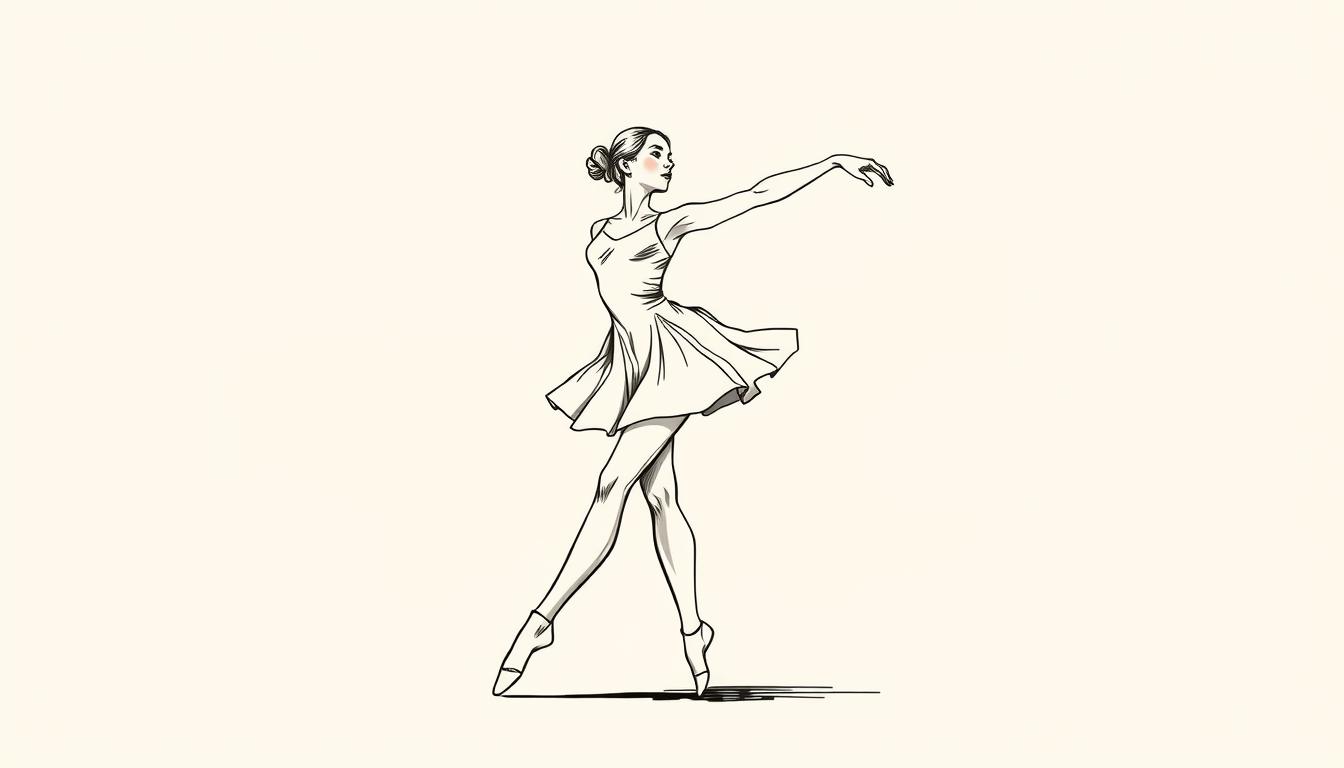Rena Horibe built her reputation on the competition floor. She trained at Ballerina School, a place known for its rigorous standards. Her talent quickly became clear in Japan’s demanding dance scene.
At just fourteen, she earned a spot among the top twelve women in the junior classical dance category. The following year, at fifteen, she repeated this feat in the senior division. This rapid climb showed remarkable artistic maturity.
She faced dancers from Japan’s most prestigious institutions. In classical ballet, every ranking hinges on precision and artistry. Horibe held her ground with quiet confidence.
Her journey reveals a dancer who evolved quickly. She maintained the intense discipline that this art form demands. This profile traces the competitive path that shaped her into a recognized name.
Introduction to Rena Horibe’s Journey
From the first moments at the barre, a commitment to excellence shaped the foundation of what would become a notable dance career. This early period reveals how discipline and passion intertwine.
Early Beginnings in Dance
Young dancers enter a world of rigorous expectations from their initial plié. The training environment demands relentless refinement of technique above raw talent.
At Ballerina School, instructors emphasized clean lines and musical interpretation. Students learned the stamina needed for performances requiring both power and grace. This place cultivated artists who understood that every movement matters.
The Spark of Passion
The drive to pursue classical ballet often ignites during childhood. The body learns movement as language before the mind articulates why it matters.
Small victories and painful corrections separate competitive dancers from casual students. Formative experiences build the resilience needed for professional placement. For this dancer, ballet defined the path early and shaped every subsequent choice.
| Training Level | Focus Areas | Key Challenges | Typical Age Range |
|---|---|---|---|
| Beginner | Basic positions, posture | Coordination, musicality | 6-9 years |
| Intermediate | Technical precision, turns | Strength development | 10-13 years |
| Advanced | Artistic expression, jumps | Performance stamina | 14-17 years |
| Pre-Professional | Repertoire, competition prep | Mental fortitude | 18+ years |
Breakthrough Moments in a Renowned Dance Career
At fourteen, a young dancer’s placement among the top twelve signaled a career-defining shift. This achievement in the junior classical dance category demonstrated remarkable progress. It marked the transition from student to serious competitor.
Key Milestones and First Major Performances
The first major competition revealed both technical precision and artistic maturity. Dancers from prestigious schools across Japan brought their best training to the stage. Each performance had to balance technical demands with emotional interpretation.
This initial success created momentum for future achievements. The experience of competing against top-tier talent built essential performance skills. It also provided valuable feedback for continued growth.
Defining Career Turning Points
Securing a place in national rankings transformed a dancer’s trajectory. This recognition opened doors to more advanced training opportunities. It also built the confidence needed for professional aspirations.
The transition from junior to senior divisions required significant adaptation. Expectations increased regarding both technical complexity and artistic depth. Each performance became a test of mental fortitude under pressure.
| Competition Level | Age Range | Technical Focus | Performance Duration |
|---|---|---|---|
| Junior Division | 13-15 years | Foundation techniques | 2-3 minute variations |
| Senior Division | 16-19 years | Advanced repertoire | 3-5 minute pieces |
| Pre-Professional | 18+ years | Full-length works | 5-10 minute performances |
| Professional | 20+ years | Artistic interpretation | Varied program lengths |
Rena Horibe: Achievements in Competitive Ballet
Achieving top placements in consecutive years demonstrates a dancer’s ability to maintain excellence. This consistency separates temporary success from lasting artistic growth.
Notable Placements and Awards
At fourteen, Horibe secured a remarkable position in the junior classical dance category. She earned a place among the top twelve women, competing against Japan’s most promising young dancers.
The following year brought greater challenges in the senior division. Maintaining her place in the top twelve required significant technical advancement. Her performance showed artistic maturity beyond her years.
These achievements resulted from blind adjudication by expert panels. Judges evaluated technical execution, musicality, and stage presence without bias. The Ballerina School foundation provided essential training, but individual discipline determined the final place.
| Achievement | Age Division | Category | Significance |
|---|---|---|---|
| Top 12 Placement | Junior (Age 14) | Classical Dance | Early recognition among peers |
| Top 12 Placement | Senior (Age 15) | Classical Dance | Sustained excellence against older competitors |
| Division Advancement | Junior to Senior | Ballet Competition | Successful adaptation to higher standards |
| Consistent Ranking | Consecutive Years | National Level | Proven reliability under pressure |
Highlighting International Dance Competitions
International dance competitions create distinct arenas for different artistic disciplines. They separate classical ballet from contemporary dance, with further divisions for women and men. This structure honors the unique physical and artistic demands of each tradition.
Classical Dance Category Highlights
The classical dance category women’s division rewards technical mastery. First place winners like Neneka Tsuji and Hono Hamasaki demonstrate flawless adagio control and allegro precision. Their performances uphold centuries of codified technique.
In the dance category men’s classical division, winners display powerful elevation and strong partnering skills. Dancers such as Momota Yasuda earned the men’s first place by meeting these specific athletic demands. The classical dance category sets a high bar for tradition.
Contemporary Dance Standouts
Contemporary dance category competitions value innovation and emotional risk. The women’s first place often goes to artists like Kaho Kimura, who push choreographic boundaries. This contemporary dance category celebrates individuality over strict form.
Winners in the contemporary dance category men’s division, such as Ryosuke Nakanishi, showcase athletic versatility. Their movement often defies classical ballet aesthetics. This framework guided artists like Rena Horibe, who trained to meet the exacting standards of the classical world.
Influential Dance Schools and Studios in Her Journey
Japan’s competitive dance landscape is shaped by a network of elite schools that consistently produce top-tier talent. These institutions build the technical foundation and artistic sensibility required for national recognition. Their training methodologies create dancers who can withstand adjudication pressure.
The relationship between a dancer and their school forms the bedrock of competitive readiness. Each institution brings distinct pedagogical approaches to classical instruction. This ecosystem of excellence pushed artists like Rena Horibe to develop their craft within rigorous environments.
Panda Ballet School (Takako Mori Ballet School) Insights
The panda ballet school established itself as a powerhouse through consistent student achievements. Known formally as takako mori ballet school, this institution produced remarkable competitors across divisions. The mori ballet school approach emphasizes both technical precision and performance readiness.
Students from this teranishi panda ballet program included Sakura Nagai, who placed second in senior classical dance. Brothers Sota and Yuto Teranishi demonstrated the school’s strength in developing male dancers. Sota won first in contemporary while Yuto took second in classical categories.
The panda ballet school methodology prepares dancers for diverse competitive demands. This takako mori ballet training balances traditional technique with contemporary interpretation. The mori ballet school clearly understands what judges seek in both disciplines.
Other Prestigious Institutions
Several other schools contributed to Japan’s competitive ballet ecosystem. Institutions like Symphony Ballet Studio and K-BALLET ACADEMY produced their own top finishers. Each school developed unique approaches to classical training.
YARITA YU BALLET STUDIO and Yuki Tokunaga Ballet School also cultivated successful competitors. This network of elite institutions created a environment where training quality directly correlated with results. Dancers emerged prepared for the demands of national competition.
Innovative Choreography and Signature Styles
The most compelling dancers understand that tradition provides a language, not a cage, for their artistry. They work within established forms to discover fresh emotional resonance.
Fusion of Tradition and Modernity
Rena Horibe’s approach to ballet demonstrates this principle perfectly. She honors classical technique while making subtle interpretive choices that feel uniquely her own.
Her signature style finds expressive possibility within movements performed for centuries. A slight shift in dynamics or phrasing can make familiar variations feel newly discovered. This requires deep technical mastery combined with creative courage.
Dancers who earn a top place in classical categories typically master this balance. They show technical accuracy that respects tradition alongside artistic interpretation that feels alive. The performance becomes more than correct—it becomes compelling.
Horibe’s competitive work reflected this understanding. Innovation in ballet means deepening your relationship to fundamental principles, not abandoning them. It’s about speaking a classic language with a contemporary voice.
Spotlight on Award-Winning Performances
Award-winning performances in competitive ballet often trace their excellence back to the training philosophies of specific studios. The right ballet studio place provides more than technique; it builds the performer’s entire approach.
Top 6 Dance Achievements
Earning a place in the top six requires a special blend of skill and training. Dancers from schools like BALLET LE COEUR frequently secure the women 1st place honor.
This achievement in the category women 1st spot highlights a ballet studio top-level program. These studio top women achievers demonstrate incredible stamina and precision. Their success is a direct result of the ballet studio place they call home.
Performance Reviews from Dance Experts
Expert reviews focus intensely on technical execution. They assess a dancer’s control, line, and musicality under pressure.
Judges look for artists who can hold a difficult place with confidence. A women 1st place performance in any category women 1st division must be flawless. It confirms a dancer’s readiness for the professional stage.
This level of recognition, as seen with Rena Horibe, separates good dancers from exceptional ones. It proves the value of a ballet studio top environment. The journey of every studio top women candidate is built on relentless studio work.
Insights from Major Dance Festivals and Events
Major dance festivals in Japan function as national crossroads for artistic development. They pull dancers from elite studios across the country onto a single stage. This exposure to different styles and teaching methods is invaluable.
Young artists see how their peers interpret the same classical variations. They absorb new approaches to musicality and expression. The experience often refines their own artistic voice.
Influence of Festival Culture on Performance Art
Festival culture establishes a clear standard of excellence. Dancers from various schools work toward a shared ideal of technical and artistic merit. This creates a common vocabulary that transcends any single studio’s preference.
Blind adjudication is a cornerstone of these events. A dancer’s place is determined purely by their performance. Technical accuracy and emotional interpretation matter more than reputation.
Participation teaches resilience. Not every outcome will match expectations. Performing in high-stakes environments builds mental strength and professional conduct.
The dance category women‘s division at these festivals showcases incredible depth. Top placements reveal which training methods are most effective. For an artist like Rena Horibe, this system provided an objective measure of her growth within the national ballet community.
Celebrating Her Signature Performance Moments
The most memorable dance routines emerge when technical mastery aligns perfectly with artistic interpretation. These moments define a dancer’s legacy beyond competition results.
Rena Horibe’s performances demonstrated this rare synthesis. Her work showed how classical tradition could feel fresh and personal.
Memorable Dance Pieces and Routines
Classical variations from Swan Lake and Don Quixote formed her competitive repertoire. Each piece demanded specific technical precision.
Her execution stood out for its musical sensitivity. She phrased movements to match the emotional arc of the music.
The table below shows key elements that distinguished her most notable performances:
| Performance Element | Technical Requirement | Artistic Quality | Judging Weight |
|---|---|---|---|
| Adagio Control | Balance and extension | Fluid transitions | 25% |
| Allegro Precision | Clean footwork | Dynamic energy | 20% |
| Stage Presence | Projection skills | Emotional connection | 30% |
| Musicality | Rhythmic accuracy | Phrasing artistry | 25% |
These elements combined to create performances that earned consistent recognition.
Award Ceremonies and Public Acclaim
Award ceremonies in competitive ballet carry significant weight. Placement results from blind adjudication by expert panels.
Horibe’s achievements built gradually through repeated excellence. The dance community noticed her consistent high-level performances.
Public acclaim in ballet develops through demonstrated skill over time. Each top placement reinforced her standing within the professional community.
Evolution of Dance Categories in Her Career
The division between classical and contemporary disciplines defines how dancers develop their technical foundation. This structural separation creates distinct pathways that shape competitive strategy from early training through professional specialization.
Understanding category evolution helps explain why certain schools produce consistent winners across different divisions.
Balancing Classical and Contemporary Styles
The classical dance category demands turnout, pointed feet, and centuries of codified positions. Dancers build their foundation here before exploring contemporary dance category possibilities.
Contemporary work values parallel positions and flexed feet. It breaks from ballet’s established vocabulary. This requires different technical approaches and artistic risk-taking.
Some institutions demonstrate remarkable versatility across both disciplines. The Yuki Tokunaga Ballet School produced top performers in classical and contemporary divisions. This tokunaga ballet school approach shows institutional adaptability.
Competitive Categories: Men vs. Women
The dance category women emphasizes line, extension, and pointe work. Women’s classical ballet focuses on fluidity and precision above all else.
Meanwhile, the dance category men prioritizes strength, elevation, and powerful turns. Male dancers face different athletic demands that require specialized training programs.
Schools like K-BALLET ACADEMY often produce category men first place winners. They address the gender imbalance found in many ballet institutions. This focus on male training creates consistent champions.
Rena Horibe specialized in the classical dance category women’s division. Her technical training aligned perfectly with these evaluative criteria.
Connecting with the Global Dance Community
The competitive circuit serves as an unexpected gateway to international artistic dialogue. Local rivalries between schools like MOMO Ballet Studio and Hakucho Ballet Academy create networks that extend worldwide.
Top performers such as Momone Sano from MOMO Ballet Studio and Daigaku Katayama from Katayama Hakucho Ballet earned invitations to overseas workshops. Their success opened doors to cultural exchange programs across continents.
International Collaborations and Cultural Exchanges
The Yoshitake Ballet Studio, run by the Yoshitake family, maintains traditions across generations. Dancers like Yusei Yoshitake from Yukari Yoshitake Ballet demonstrate this continuity.
Brothers Sota Teranishi and Yuto Teranishi from Panda Ballet School achieved recognition that attracted foreign attention. Their studio second place finishes still represented significant achievement.
Schools including Symphony Ballet Studio and Mai Ballet Studio form Japan’s competitive infrastructure. Dancers from these institutions bring back technical insights from international competitions.
Cultural exchanges flow both directions as global companies recognize Japanese dancers’ precision. This appreciation stems from the demanding training that produces top placements.
Final Reflections on a Stellar Dance Journey
Rena Horibe’s career stands as a testament to what focused training and artistic courage can achieve. It reflects a common yet demanding path for dancers in Japan, built on rigorous studio work and validated by competitive success.
Her consistent high place in national rankings demonstrated more than technical skill. It showed the mental discipline required to perform under pressure, year after year.
This journey connects her to a generation of artists upholding classical standards while adding personal expression. The network of schools, teachers, and competitors in Japan’s ballet world provides a foundation for such growth.
Ultimately, her story is exemplary. It offers a clear-eyed view of the dedication needed to make a difficult art form appear effortless and profoundly moving.




